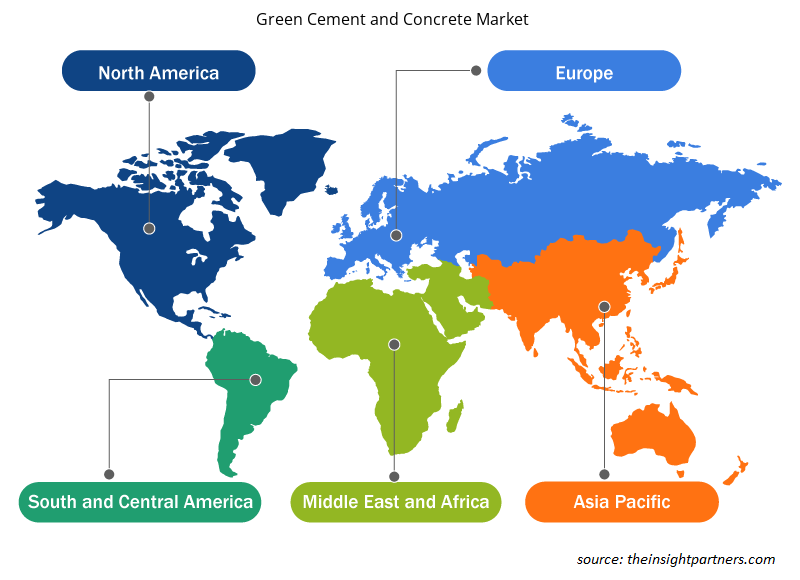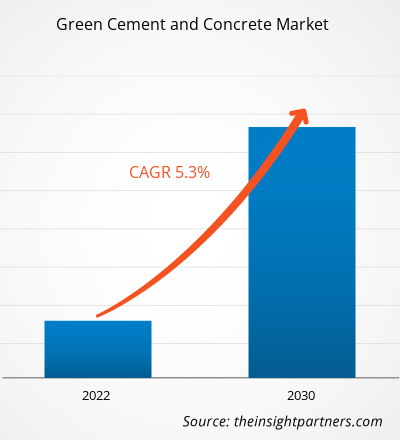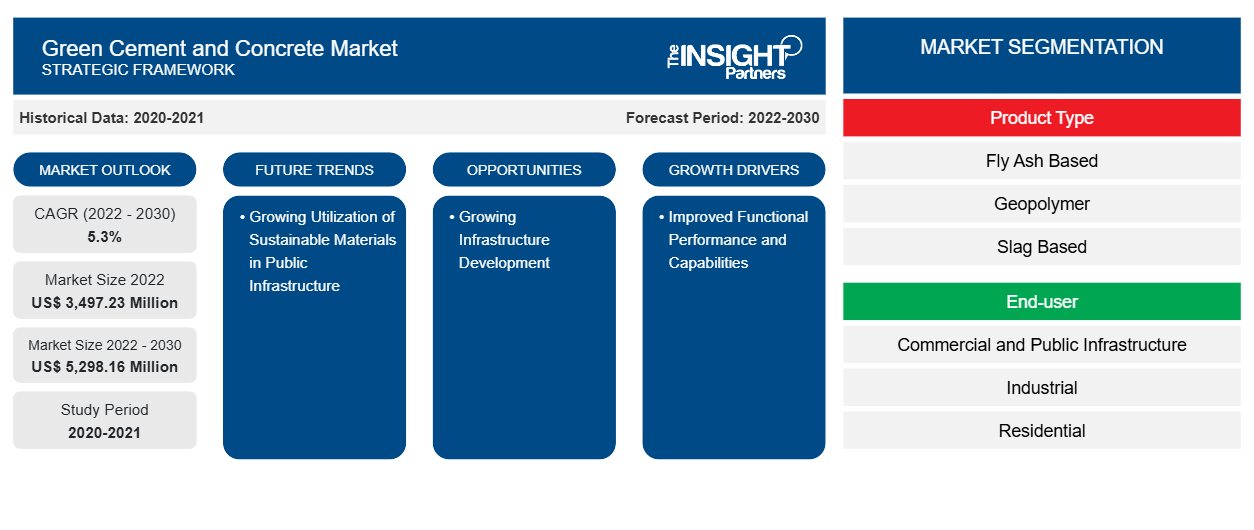من المتوقع أن يصل حجم سوق الأسمنت والخرسانة الخضراء إلى 5298.16 مليون دولار أمريكي بحلول عام 2030 من 3497.23 مليون دولار أمريكي في عام 2022. ومن المتوقع أن يسجل السوق معدل نمو سنوي مركب بنسبة 5.3٪ في الفترة 2022-2030. تنفذ العديد من البلدان خرائط طريق لإزالة الكربون من صناعة الأسمنت مما يعزز الطلب على الأسمنت والخرسانة الخضراء على مستوى العالم.
تحليل سوق الأسمنت والخرسانة الخضراء
تعد صناعة الأسمنت واحدة من الصناعات الرئيسية التي تعتمد على الكربون، ومن المتوقع أن يكون لها تأثير سلبي على حماية البيئة. وبالتالي، من المتوقع أن يؤدي الاهتمام المتزايد بتخفيف تأثير الكربون على البيئة والتركيز على زيادة نهج الاستدامة إلى دفع نمو سوق الأسمنت والخرسانة الخضراء على مستوى العالم.
نظرة عامة على سوق الأسمنت والخرسانة الخضراء
ومن المتوقع أن تعمل المبادرات الحكومية المتنامية والسياسات المشجعة على تعزيز تكامل الأسمنت والخرسانة الخضراء المستدامة في أساسات البنية الأساسية العامة. على سبيل المثال، من المتوقع أن يتم بناء العديد من مشاريع البنية الأساسية القادمة في الهند، مثل مشروع تطوير وادي نارمادا، ومشروع بهاراتمالا باريوجانا، وجسر سكة حديد نهر تشيناب، ومشروع مومباي ترانس هاربور، وممر مترو دلهي الصناعي، ومشروع نافي مومباي الدولي، باستخدام الأسمنت والخرسانة الخضراء. وبالتالي، من المتوقع أن يحافظ الانتشار المتزايد للأسمنت الأخضر كبديل قابل للتطبيق للأسمنت التقليدي على تطبيقه المتنامي في قطاع البنية الأساسية التجارية والعامة.
قم بتخصيص هذا التقرير ليناسب متطلباتك
ستحصل على تخصيص لأي تقرير - مجانًا - بما في ذلك أجزاء من هذا التقرير، أو تحليل على مستوى الدولة، وحزمة بيانات Excel، بالإضافة إلى الاستفادة من العروض والخصومات الرائعة للشركات الناشئة والجامعات
-
احصل على أهم اتجاهات السوق الرئيسية لهذا التقرير.ستتضمن هذه العينة المجانية تحليلاً للبيانات، بدءًا من اتجاهات السوق وحتى التقديرات والتوقعات.
محركات وفرص سوق الأسمنت والخرسانة الخضراء
تحسين الأداء الوظيفي والقدرات التي تدفع الطلب على الأسمنت والخرسانة الخضراء
تتطلب عملية إنتاج الأسمنت القياسي كمية كبيرة من الغاز الطبيعي لأغراض التدفئة. يتم تصنيع الأسمنت الأخضر من المنتجات الثانوية الصناعية، مما يجعل عملية الإنتاج أكثر كفاءة في استخدام الطاقة. يتميز الأسمنت الأخضر بمقاومة أكبر للحرائق ويستغرق وقتًا أقل للتصلب من الأسمنت القياسي الآخر. تتمتع المباني المبنية باستخدام الأسمنت الأخضر بعمر أطول. تتبع عملية تصنيع الأسمنت الأخضر تقنيات متطورة يمكنها تقليل انبعاثات الكربون، مما يتسبب في الحد الأدنى من التلوث. يتطلب إنتاج الأسمنت الأخضر تطبيق المنتجات الثانوية، مثل خبث فرن الصهر، ورماد السيليكا المتطاير ، والحديد، وهي فعالة من حيث التكلفة. يمتلك الأسمنت الأخضر 0.5-0.6٪ ثاني أكسيد الحديد في خصائصه، مما يوفر القوة لصلابة ولون الأسمنت. يجف هذا الأسمنت بسرعة وله معدل انكماش ضئيل. إنه يدوم لفترة أطول ويشكل بديلاً أكثر استدامة للبيئة. يوفر الأسمنت الأخضر أيضًا عزلًا حراريًا عالي الجودة ومقاومة للحريق. يعد الأسمنت الأخضر بديلاً أكثر ملاءمة للمناطق ذات الحركة المرورية الكثيفة مثل الطرق والجسور والمطارات، لأنه يمكنه تحمل الأحمال الثقيلة. ومن ثم، فإن مستوى الأداء العالي للأسمنت الأخضر وقدراته من حيث المتانة والقوة والمقاومة يدفع السوق إلى الأمام.
تنمية البنية التحتية المتنامية – فرصة في سوق الأسمنت والخرسانة الخضراء
إن زيادة التمويل للبنية التحتية المستدامة يفتح الطريق أمام فرص الأسمنت والخرسانة الخضراء، مما يعزز الاستفادة من البدائل الصديقة للبيئة ويشجع التنمية الاقتصادية. كما يوفر مسارًا للدول لدمج أهدافها المتعلقة بتطوير البنية التحتية والمناخ من خلال المشاركة في المشاريع التي تقلل من وجود الكربون، بما في ذلك أنظمة البناء والتصنيع المستدامة والخضراء. تركز صناعة البناء والبنية التحتية على تقليل بصمتها الكربونية، لأنها المساهم الرئيسي في التلوث البيئي. وبالتالي، من المتوقع أن يوفر التركيز المتزايد على الأسمنت والخرسانة الخضراء في تطوير البنية التحتية فرصًا كبيرة للسوق.
تقرير تحليلي لتجزئة سوق الأسمنت والخرسانة الخضراء
إن القطاعات الرئيسية التي ساهمت في استنتاج تحليل سوق الأسمنت الأخضر والخرسانة هي نوع المنتج والمستخدم النهائي.
- بناءً على نوع المنتج، تم تقسيم سوق الأسمنت والخرسانة الخضراء إلى قائمة على الرماد المتطاير، والجيوبوليمر، والقائمة على الخبث، وغيرها. احتلت شريحة الرماد المتطاير حصة سوقية أكبر في عام 2022.
- بناءً على المستخدم النهائي، تم تقسيم سوق الأسمنت والخرسانة الخضراء إلى البنية التحتية التجارية والعامة والصناعية والسكنية. احتل قطاع البنية التحتية التجارية والعامة حصة سوقية أكبر في عام 2022.
تحليل حصة سوق الأسمنت والخرسانة الخضراء حسب المنطقة الجغرافية
ينقسم النطاق الجغرافي لتقرير سوق الأسمنت والخرسانة الخضراء بشكل أساسي إلى خمس مناطق: أمريكا الشمالية، ومنطقة آسيا والمحيط الهادئ، وأوروبا، والشرق الأوسط وأفريقيا، وأمريكا الجنوبية/أمريكا الجنوبية والوسطى.
إن المخاوف البيئية المتزايدة والتركيز على الاستفادة من البدائل المستدامة في صناعة الأسمنت هي التي تدفع نمو سوق الأسمنت والخرسانة الخضراء في منطقة آسيا والمحيط الهادئ. وقد حددت دول مثل الصين والهند، وهما من كبار منتجي الأسمنت، الحاجة إلى التحول إلى ممارسات إنتاج أسمنت أكثر ملاءمة للبيئة. وعلاوة على ذلك، تتخذ حكومات مختلف البلدان تدابير مختلفة لجذب التمويل الخاص في مشاريع تطوير البنية التحتية. كما أن توسيع الاستثمارات في مشاريع البناء السكنية والتجارية يعزز الطلب على مواد البناء المتقدمة، بما في ذلك حلول الأسمنت والخرسانة الخضراء ، في دول آسيا والمحيط الهادئ.
رؤى إقليمية حول سوق الأسمنت والخرسانة الخضراء
لقد قام المحللون في Insight Partners بشرح الاتجاهات والعوامل الإقليمية المؤثرة على سوق الأسمنت والخرسانة الخضراء طوال فترة التوقعات بشكل شامل. يناقش هذا القسم أيضًا قطاعات سوق الأسمنت والخرسانة الخضراء والجغرافيا في جميع أنحاء أمريكا الشمالية وأوروبا ومنطقة آسيا والمحيط الهادئ والشرق الأوسط وأفريقيا وأمريكا الجنوبية والوسطى.

- احصل على البيانات الإقليمية المحددة لسوق الأسمنت والخرسانة الخضراء
نطاق تقرير سوق الأسمنت والخرسانة الخضراء
| سمة التقرير | تفاصيل |
|---|---|
| حجم السوق في عام 2022 | 3,497.23 مليون دولار أمريكي |
| حجم السوق بحلول عام 2030 | 5,298.16 مليون دولار أمريكي |
| معدل النمو السنوي المركب العالمي (2022 - 2030) | 5.3% |
| البيانات التاريخية | 2020-2021 |
| فترة التنبؤ | 2022-2030 |
| القطاعات المغطاة |
حسب نوع المنتج
|
| المناطق والدول المغطاة |
أمريكا الشمالية
|
| قادة السوق وملفات تعريف الشركات الرئيسية |
|
كثافة اللاعبين في سوق الأسمنت والخرسانة الخضراء: فهم تأثيرها على ديناميكيات الأعمال
يشهد سوق الأسمنت والخرسانة الخضراء نموًا سريعًا، مدفوعًا بالطلب المتزايد من المستخدم النهائي بسبب عوامل مثل تفضيلات المستهلكين المتطورة والتقدم التكنولوجي والوعي المتزايد بفوائد المنتج. ومع ارتفاع الطلب، تعمل الشركات على توسيع عروضها والابتكار لتلبية احتياجات المستهلكين والاستفادة من الاتجاهات الناشئة، مما يؤدي إلى زيادة نمو السوق.
تشير كثافة اللاعبين في السوق إلى توزيع الشركات أو المؤسسات العاملة في سوق أو صناعة معينة. وهي تشير إلى عدد المنافسين (اللاعبين في السوق) الموجودين في مساحة سوق معينة نسبة إلى حجمها أو قيمتها السوقية الإجمالية.
الشركات الرئيسية العاملة في سوق الأسمنت والخرسانة الخضراء هي:
- شركة ايه سي سي للاسمنت (مجموعة اداني)
- شركة الصين الوطنية لمواد البناء المحدودة (CNBM)
- شركة جرين سيمنت
- أسمنت محارة آنهوي
- شركة هولسيم المحدودة
- شركة جيه إس دبليو للأسمنت المحدودة
إخلاء المسؤولية : الشركات المذكورة أعلاه ليست مرتبة بأي ترتيب معين.

- احصل على نظرة عامة على أهم اللاعبين الرئيسيين في سوق الأسمنت والخرسانة الخضراء
أخبار وتطورات سوق الأسمنت والخرسانة الخضراء
يتم تقييم سوق الأسمنت والخرسانة الخضراء من خلال جمع البيانات النوعية والكمية بعد البحث الأولي والثانوي، والتي تتضمن منشورات الشركات المهمة وبيانات الجمعيات وقواعد البيانات. فيما يلي قائمة بالتطورات في السوق فيما يتعلق بالابتكارات وتوسيع الأعمال والاستراتيجيات:
- في فبراير 2023، أطلقت شركة هولسيم أول عملية لإنتاج الأسمنت الطيني المحروق في أوروبا في مصنعها في سان بيير لا كور في فرنسا لتقديم أسمنت إيكوبلانيت الأخضر الذي يقل انبعاثاته من ثاني أكسيد الكربون بنسبة 50% مقارنة بالأسمنت القياسي (CEM I). (المصدر: شركة هولسيم المحدودة، بيان صحفي/موقع الشركة على الإنترنت/النشرة الإخبارية)
- في سبتمبر 2023، وقعت شركة Hoffmann Green Cement Technologies اتفاقية شراكة مع شركة Point. P. وبموجب شروط الاتفاقية، يتم توزيع منتجات الأسمنت الخالية من الكلنكر من شركة Hoffmann Green Cement Technologies على مصانع الخرسانة الجاهزة (RMC) ومصانع الخلط التابعة لشركة Point. P. (المصدر: شركة Hoffmann Green Cement Technologies، بيان صحفي/موقع الشركة على الويب/النشرة الإخبارية)
تقرير سوق الأسمنت والخرسانة الخضراء: التغطية والنتائج المتوقعة
يوفر تقرير "حجم سوق الأسمنت والخرسانة الخضراء والتوقعات (2020-2030)" تحليلاً مفصلاً للسوق يغطي المجالات التالية:
- حجم سوق الأسمنت والخرسانة الخضراء وتوقعاته على المستويات العالمية والإقليمية والوطنية لجميع قطاعات السوق الرئيسية التي يغطيها النطاق
- ديناميكيات السوق مثل المحركات والقيود والفرص الرئيسية
- اتجاهات سوق الأسمنت والخرسانة الخضراء
- تحليل مفصل لـ PEST و SWOT
- تحليل سوق الأسمنت والخرسانة الخضراء يغطي اتجاهات السوق الرئيسية والإطار العالمي والإقليمي والجهات الفاعلة الرئيسية واللوائح والتطورات الأخيرة في السوق
- صناعة الأسمنت والخرسانة الخضراء، وتحليل المشهد والمنافسة، وتغطية تركيز السوق، وتحليل خريطة الحرارة، واللاعبين البارزين، والتطورات الأخيرة
- ملفات تعريف الشركة التفصيلية
- التحليل التاريخي (سنتان)، سنة الأساس، التوقعات (7 سنوات) مع معدل النمو السنوي المركب
- تحليل PEST و SWOT
- حجم السوق والقيمة / الحجم - عالمي، إقليمي، بلد
- الصناعة والمنافسة
- مجموعة بيانات إكسل
التقارير الحديثة
تقارير ذات صلة
شهادات العملاء
سبب الشراء
- اتخاذ قرارات مدروسة
- فهم ديناميكيات السوق
- تحليل المنافسة
- رؤى العملاء
- توقعات السوق
- تخفيف المخاطر
- التخطيط الاستراتيجي
- مبررات الاستثمار
- تحديد الأسواق الناشئة
- تحسين استراتيجيات التسويق
- تعزيز الكفاءة التشغيلية
- مواكبة التوجهات التنظيمية























 احصل على عينة مجانية ل - سوق الأسمنت والخرسانة الخضراء
احصل على عينة مجانية ل - سوق الأسمنت والخرسانة الخضراء